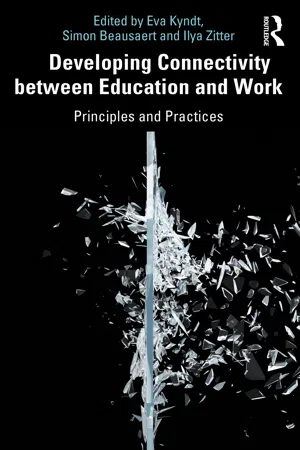
Developing Connectivity between Education and Work
Principles and Practices
- 240 pages
- English
- ePUB (mobile friendly)
- Available on iOS & Android
Developing Connectivity between Education and Work
Principles and Practices
About this book
Future-oriented education needs to invest in the connectivity between learning and working in order to realise its full potential. This book presents guiding principles on how to build these successful connections. By taking an educational perspective and enriching it with insights from human resource development, this book explores the why, how and what of designing for connectivity.
This edited volume presents the current knowledge about educational practices and principles that help to realise connectivity between learning and working experiences. Introducing the central perspectives of workplace learning and learning environments at the boundary of school and work, this book presents key research that examines how educators and professionals from organisations and schools can come together with the purpose of realising connectivity in educational programmes. Empirical research showcasing both theoretical and practical insights from real life cases are at the heart of this book. Considering the barriers to achieving connectivity, this book also focuses on how it can be achieved, with ideas and guidance about communication, design principles and best practices.
Using carefully chosen international examples, this book is ideal reading for policy makers, practitioners and researchers looking to learn more about connecting learning and working experiences.
Frequently asked questions
- Essential is ideal for learners and professionals who enjoy exploring a wide range of subjects. Access the Essential Library with 800,000+ trusted titles and best-sellers across business, personal growth, and the humanities. Includes unlimited reading time and Standard Read Aloud voice.
- Complete: Perfect for advanced learners and researchers needing full, unrestricted access. Unlock 1.4M+ books across hundreds of subjects, including academic and specialized titles. The Complete Plan also includes advanced features like Premium Read Aloud and Research Assistant.
Please note we cannot support devices running on iOS 13 and Android 7 or earlier. Learn more about using the app.
Information
Section 1
Setting the stage
Chapter 1.1
Connectivity between education and work
Theoretical models and insights
Introduction
Connectivity through facilitating integrative learning processes
Table of contents
- Cover
- Half Title
- Title Page
- Copyright Page
- Table of Contents
- Lists of figures
- List of tables
- Preface
- List of contributors
- Section 1: Setting the stage
- Section 2: Designing across boundaries
- Section 3: Boundary objects for connectivity
- Section 4: Guidance for connectivity
- Index